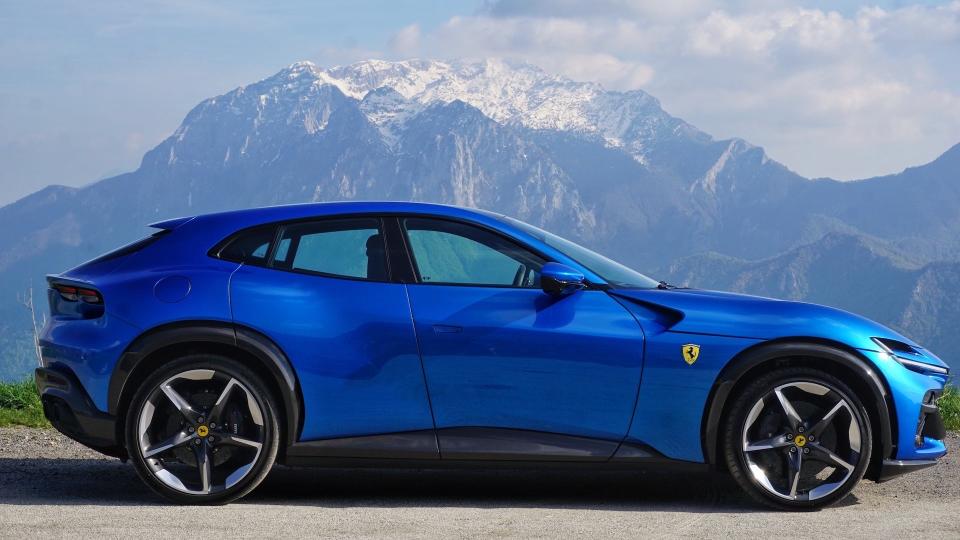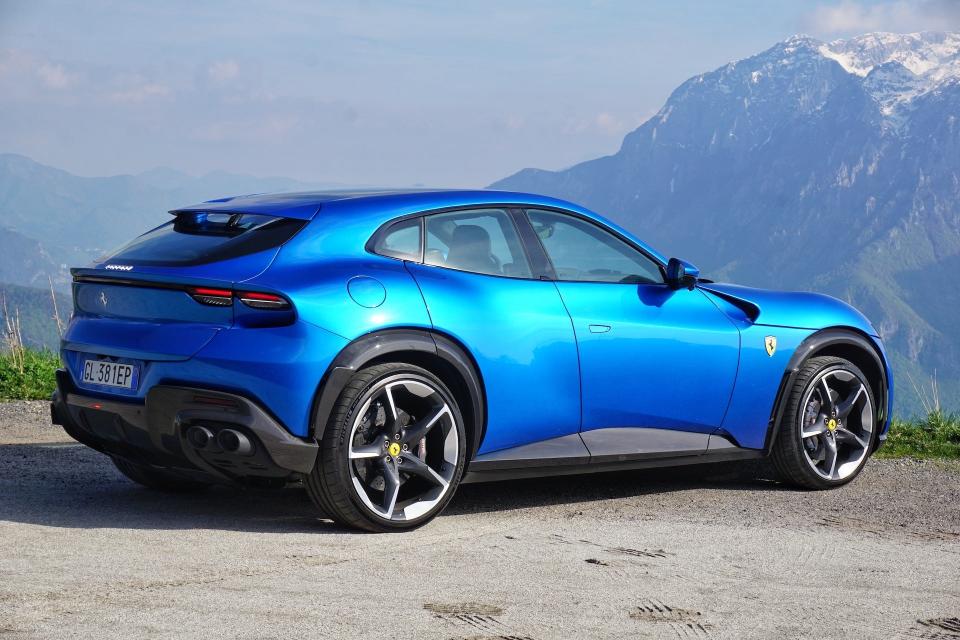2024 Ferrari Purosangue Review: A Worthy Supercar, Now in Family Size

Let’s skip over the part where you can’t believe Maranello actually built an SUV, crossover, “lifted utility vehicle,” whatever the hell you want to call it. Spending one second decrying this decision is genuinely one second too long. The 2024 Ferrari Purosangue is here in all of its 12-cylinder, four-door, four-seat, all-wheel-drive glory, and it doesn’t care what you think. Why? Because, first and foremost, it has a Cavallino Rampante on the hood, and because every single production slot is sold out until 2026. That’s why.
It’s not often that I—or any other automotive journalist, for that matter—get to test a truly first-of-a-kind vehicle. I’m not referring to a brand-new model or the reincarnation of a long-gone nameplate. No, I’m talking about the very first of something. I’m talking about the first-ever Ferrari SUV—even if Ferrari refuses to call it that. (It prefers “first-ever four-door, four-seater car.”)


Even in a segment jam-packed with high-performance SUVs, the Purosangue is the only single-trim, bespoke model in existence. Forget about your Mercedes-AMGs, your BMW Ms, Porsche Cayennes, and yes, even your Lamborghini Uruses. The Purosangue shares a platform with no one, and it certainly doesn’t exist as a business case to up-badge an existing SUV. If anything, only the Aston Martin DBX comes close.
So, the Purosangue is special, expensive, and also sold out. But what’s it like? How does it stack against other admittedly-capable SUVs? And most importantly, is it a real Ferrari? That’s exactly what I set out to find out over the course of two days in the mountains of Northern Italy.
2024 Ferrari Purosangue Specs
Base price (as tested): $397,300 ($493,707)
Powertrain: 6.5-liter naturally aspirated V12 | 8-speed dual-clutch automatic | all-wheel drive
Horsepower: 715 @ 7,750 rpm
Torque: 528 lb-ft @ 6,250 rpm
Seating capacity: 4
Curb weight: 4,481 pounds (dry)
EPA estimated fuel economy: TBA
Quick take: Some say Ferrari has sold its soul to the devil. I say, lucky devil.
Score: 9.5/10




The Basics
First, the name. Ferrari shuts down any blasphemous talk with a name that punches straight and punches hard: Purosangue. Puro, meaning pure, and sangue, meaning blood. Pureblood or thoroughbred—however you translate it—means one thing: it is as much a Ferrari as any other model that rolls out of Maranello. As to how to properly pronounce the name; you can listen to this accurate example. Puttosangweh.
The styling of the Purosangue has been controversial from the beginning, and it was made even more so after memes comparing it to a Mazda and a Prius made the rounds on social media. Blasphemy. What you can’t appreciate in photographs is just how refined the body really is, how curvy.




The low-sitting front end allows the massive V12 to breathe, but more specifically, it directs airflow in a number of ways and for multiple purposes. The air intakes around the DRLs guide air through the top of the tires, while the “floating” fender walls and flares serve as exhaust to excess air that might otherwise generate lift. The grille feeds air to the V12 so it can sing its song all the way up to 8,250 rpm while the smaller lateral intakes help with wake management by channeling air around the wheels. Then there’s the hood, which is a massive, sculpted piece of cold-stamped aluminum. Seriously, it’s hard to understand how enormous the hood (hinged at the front, of course) is until it’s fully open before you. I’m six feet tall and it towered over me by another foot, if not more. The hood itself has two air inlets that carry over onto the side of the car à la F12—Ferrari actually calls this an “aerobridge.”
According to engineers, it was the overall curvature of the car that presented the biggest aerodynamic challenge, which is why they kept the roof low and the tailgate angle as flush as possible with the rest of the car. Look closely and the angle of the rear window is drastically different than that of the windshield, giving the Purosangue a coupe, fastback-like profile. The rear windshield doesn’t even have a wiper, as engineers claim it doesn’t need one thanks to such ideal airflow over the roof.



As is the case with all Ferraris, the engine is the heart of the Purosangue. Derived from the hardcore 812 Competizione, this 6.5-liter V12 packs F1-derived engine mapping and a mix of new and revised internals that shape its character. A redesigned intake manifold is tasked with increasing torque and works in combination with the also-redesigned camshaft to offer a linear power curve (one less peaky than in the 812). The intake system is also revised, as well as the exhaust and injection systems. And while maximum power is always the goal, some components were also tuned for efficiency, too. For example, the geometry of the crankshaft, connecting rods, and pistons was modified to improve fuel consumption. Even the lubrication of these components was tweaked in order to increase efficiency and improve reliability.



The eight-speed transmission has been fully redesigned for the Purosangue, featuring a wet dual-clutch and dry sump architecture. This translates into a smaller and lighter unit compared to the seven-speed used in other models, while also improving shift times by 30%.
Driving the Ferrari Purosangue
Open the door and step inside the Purosangue. Did you feel that? You just stepped in—no circus act, no special procedure. Most noticeably, no barely squeezing in if you’re a big guy like me. Just throw a leg over and take a seat. The door opening is wide and generous, and while it still sits a lot lower than your average vehicle, it’s an easy ingress. Ferrari didn’t disclose how many ways the front seats are power-adjustable, but it’s a lot—and one of my favorite parts of the car, for sure. Remember, a good driving experience begins with a really good driving position. The bolstering, the firmness, and the angle of every section of the seat can be adjusted. You can, in fact, spend 10 hours sitting in one. And when you start to feel tired, turn on the massage function—a Ferrari first—and buckle up for another 10. That’s not something I can say about my experience in the F8 Tributo, or perhaps even the Roma.




 Yahoo Autos
Yahoo Autos 